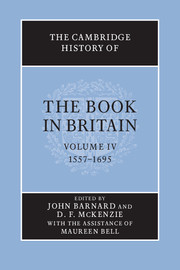Book contents
- Frontmatter
- Dedication
- Contents
- List of illustrations
- List of contributors
- Preface
- Acknowledgements
- Introduction
- RELIGION AND POLITICS
- ORAL TRADITIONS AND SCRIBAL CULTURE
- LITERATURE OF THE LEARNED
- 6 The Latin trade
- 7 Patronage and the printing of learned works for the author
- 8 University printing at Oxford and Cambridge
- 9 Editing the past: classical and historical scholarship
- 10 Maps and Atlases
- 11 The literature of travel
- 12 Science and the book
- 13 Samuel Hartlib and the commonwealth of learning
- 14 Ownership: private and public libraries
- 15 Monastic collections and their dispersal
- LITERARY CANONS
- VERNACULAR TRADITIONS
- THE BUSINESS OF PRINT AND THE SPACE OF READING
- BEYOND LONDON: PRODUCTION, DISTRIBUTION, RECEPTION
- DISRUPTION AND RESTRUCTURING: THE LATE SEVENTEENTH-CENTURY BOOK TRADE
- STATISTICAL APPENDICES
- Abbreviations
- Bibliography
- Index
- Plate Section
- References
10 - Maps and Atlases
from LITERATURE OF THE LEARNED
- Frontmatter
- Dedication
- Contents
- List of illustrations
- List of contributors
- Preface
- Acknowledgements
- Introduction
- RELIGION AND POLITICS
- ORAL TRADITIONS AND SCRIBAL CULTURE
- LITERATURE OF THE LEARNED
- 6 The Latin trade
- 7 Patronage and the printing of learned works for the author
- 8 University printing at Oxford and Cambridge
- 9 Editing the past: classical and historical scholarship
- 10 Maps and Atlases
- 11 The literature of travel
- 12 Science and the book
- 13 Samuel Hartlib and the commonwealth of learning
- 14 Ownership: private and public libraries
- 15 Monastic collections and their dispersal
- LITERARY CANONS
- VERNACULAR TRADITIONS
- THE BUSINESS OF PRINT AND THE SPACE OF READING
- BEYOND LONDON: PRODUCTION, DISTRIBUTION, RECEPTION
- DISRUPTION AND RESTRUCTURING: THE LATE SEVENTEENTH-CENTURY BOOK TRADE
- STATISTICAL APPENDICES
- Abbreviations
- Bibliography
- Index
- Plate Section
- References
Summary
The production of printed maps and atlases in the British Isles has long been a specialized activity standing somewhat apart from the generality of book production. This has to a large extent been true ever since maps first began to appear as illustrations in London-printed books of the mid-sixteenth century. The reasons for this were primarily technical. Map publishing required skills in making and printing blocks or plates quite separate from those involved in the setting and printing of type. Map publishers were noticeably earlier than the book trade at large to adopt intaglio printing from engraved metal plates, a factor that from the beginning set them apart, for intaglio plates (unlike woodcuts which could be printed alongside ordinary letterpress) required a quite different type of printing press (the ‘rolling-press’) and, at least to some extent, specialized inks and papers. A further difference is that the trade in maps and atlases is inherently international, with maps requiring little in the way of translation. This led to extreme vulnerability to overseas competition, but also to extensive and in some ways atypical interrelationships between members of the domestic trade and their counterparts abroad.
The map trade is itself difficult to define. Individual maps might be sold separately, either in single sheets or as several sheets joined to make a wall map for display. Maps might also appear as book illustrations or as part of an atlas (here very loosely defined as any production of which the maps form an essential feature). Many survive only as part of a composite ‘atlas factice’ of maps from different sources assembled or ‘published’ in non-standard form.
- Type
- Chapter
- Information
- The Cambridge History of the Book in Britain , pp. 228 - 245Publisher: Cambridge University PressPrint publication year: 2002
References
- 2
- Cited by

